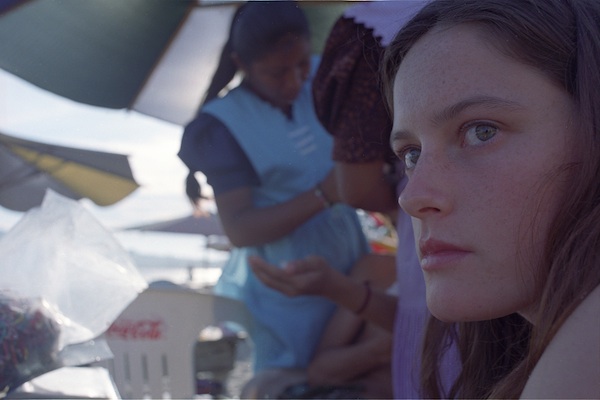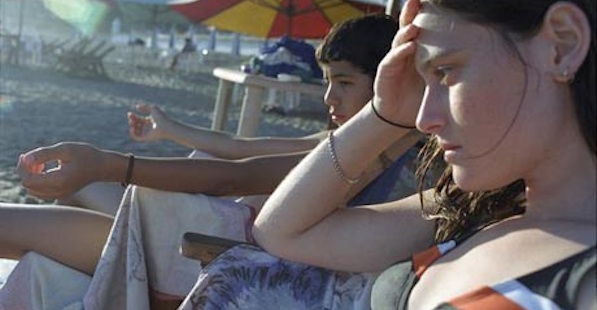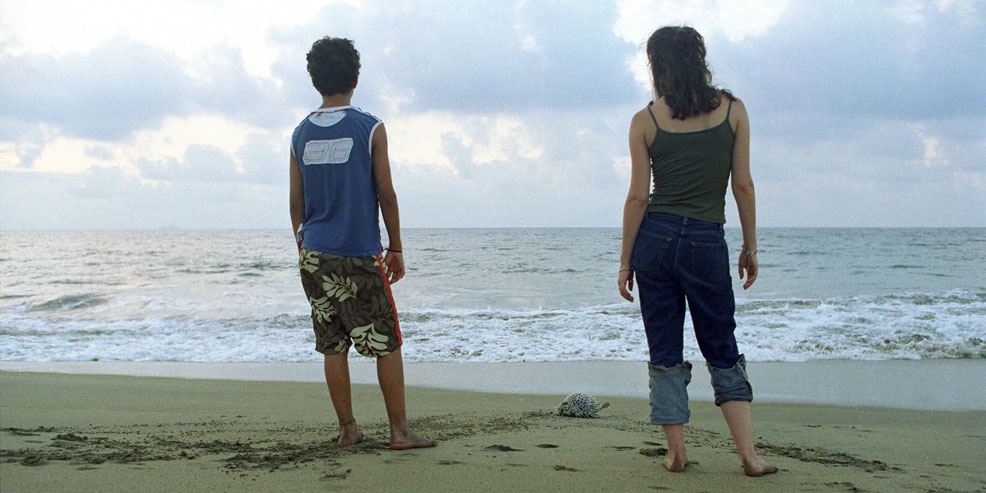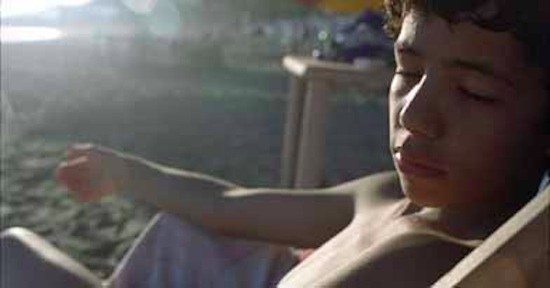The baby in the background of our Skype phone call sounds newly verbal—an evidently content child just learning to use his voice. Which makes me think of a line of dialogue in Año uña, a film my interviewee, Eireann Harper made with her partner, Jonás Cuarón, half a dozen years prior. Harper’s character, Molly, tries to free herself from her father’s expectations by saying “I just want to be a mother.” It was a barbed line—and one of a thousand bright pops of color and motion in this black-and-white film made completely of still photographs. It’s as if writer/director Jonás Cuarón re-imagined Chris Marker’s La jetée with stills of his family and friends. His is a rather illustrious family: he and his father Alfonso Cuarón are on the fast track to the Oscars with this fall’s Gravity (written by the son, directed by the father) and friends like veteran actor Jesús Ochoa appear round the dinner table in the family photos.
In the story, Molly (Harper) is traveling to Mexico, castigating herself regularly for not taking photographs (it’s almost an inside joke). Diego (Cuarón‘s little brother, Diego Cataño), eventually lands in Molly’s orbit. A fourteen-year-old hornball who recently jammed his toenail in a fútbol match (lending the film a title: Year of the Nail) he’s got an impossible crush on the coed. Impossible, but we project a connection. These kids aren’t romantically compatible; they just find each other in the fray as Molly struggles with adulthood and Diego is trying so not to be a little boy. Their world is comprised of old places: ruins, historic churches, the beach, but they—like the film—are emerging.
Año uña played Venice Film Festival in 2007, the same year Harper and Jonás Cuarón married. Recently Harper has returned to her old love: photography. She spoke to me on Monday about photos, time and Jonás.
Keyframe: Diego has a lot of ‘unclean thoughts’ about Molly. How did your [now] husband feel about this scenario he came up with involving his ‘girl’?
Eireann Harper: I think the idea was to create a story and work with what he had in the pictures. In writing the character of Diego, he remembered how he was when he was a teenager; figuring out how to talk to girls and what that meant and how it helped him define himself. Beyond the practicality of finding a scenario to get the characters together and on a beat he was trying to bring to life what it means to be a fourteen-year-old boy—the heartbreak and awkwardness and how to approach things like sexuality but also how you want to move in the world.
Keyframe: What do you mean by ‘move in the world?’
Harper: I think that a lot of what being a teen is: learning how to be independent. You see that a little when Diego runs away to chase after Molly—though there’s no sign there’s anything worth chasing—but when you’re acting a little more adult, part of your way of becoming independent is doing things like acting on impulse, which is what he ends up doing in the third act so that kind of search for independence goes hand in hand with his own idea of how to become an adult and connect with Molly on an even playing field.
Keyframe: How did you decide to create this particular relationship?
Harper: Jonás started taking photographs of the people around him and the situations he was in and at that time they were just meant to be candid photographs and the story came later. So the characters were chosen basically because they were the people who occurred the most in the photos he took. He had about 8,000 photos by the end of the year and from those he chose the people that ended up being the principle characters because he spent most of that year with me and his younger brother, who ended up being Diego. So he edited them and from there developed a fictional narrative.
Keyframe: In that method, is the image secondary to the story?
Harper: I think they both carry their own weight in the sense that the characters came about only because that’s what we were looking at in the pictures so they both sort of play their own roles. I don’t think Jonás would have written a film about an American twenty-year-old visiting a Mexican fourteen-year-old but it was a great way to foreground the screenplay because he was able to create a parallel universe.
Keyframe: At times you feel you’re watching a family slideshow. Was any one image the jumping off point for the story?
Harper: Jonás has always been interested in writing. He began as a writer before anything else and in school he ended up studying studio art and English literature so he started taking the photos as part of a class to see where he could push photography. But I think he’s a very narrative thinker and when he saw all this material he started thinking of all the possibilities and it was compelling to him that we tend to judge photographs as something that represents a truth that has definitely happened. As a culture, we look to photos as proof of an event and he thought it was interesting to see if he could play with the idea that they’re not what they appear. That’s how he came at the idea of writing a screenplay that would give characters to these images and change entirely what they mean. After he’d written the story we’d been watching films like La jetée and he decided the next logical step was to do voiceover and give them a movement through the editing process that would allow them to be viewed as a narrative film.
Keyframe: It forces us to project. For example: the ‘chemistry’ between you and Diego in the pictures?
Harper: When we went to the beach it was the first time Jonás had traveled with his brother and his girlfriend, and Diego was in a very bad mood with me. We created an interplay between documentary and fiction and I’m glad to hear something came through in the photos because that means something worked there.
Keyframe: Well, we’re trying to figure out the feelings as we see them, and seeing them on record matters—like you said, it’s proof. Your character, Molly, is always lamenting how few pictures she’s taken. Is that related?
Harper: Molly’s a character with a hard time being proactive about her life, so she has plans and ideas about the world but gets stuck before she takes a step towards any of them. Photography is one aspect of her personality that shows she’s not able to move forward and take advantage of all the things she keeps trying to move towards. In terms of the relationship with the structure of the film I think in a way the film is a dialogue about photography. The whole issue of photographs and photography runs parallel to the two characters and how we can capture a moment. I don’t think she’s necessarily making her own photo gallery as we watch the film but there is a discourse that’s ongoing about photography that highlights the different aspects of Molly’s character.
Keyframe: The ingrown toenail—the ‘uña’ of the ‘Año’—resembles a symbol of maturity but it’s also…removable.
Harper: A lot of what we did in the film is to create cognitive dissonance, to keep you unsure about what’s real and what isn’t. The photos represent what took place [in life] but the story is clearly different. Jonás had an ingrown toenail and he went to the doctor to deal with it and the doctor pulled off his toenail and in that sense this film is very personal. It played a lot with what we were all living at that moment and it managed to do it in a way where the characters hopefully speak to something more universal and take those personal situations and makes them something we can all relate to. The things we were going through were about nationality and growing up and possible romance and everyone at some point can remember and feel a part of and that was also why we liked playing with the idea of the family album. It started out that way: as candids about family and friends. And it took on another life once the fiction was overlaid and we did the acting and brought the stories together but a lot of the concept was ‘how do we take something that’s a unique experience and make it something bigger?’—something that can be a narrative others can see their own family albums in.







